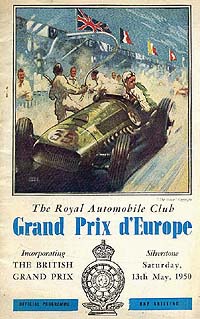 I keep receiving press releases about 60 years of Formula One and I cannot understand why because they are four years late. Formula One, originally called Formula A, did not officially come into force until 1947, but three races were run to the formula in 1946. Unlike the PR bumf, this is fact.
I keep receiving press releases about 60 years of Formula One and I cannot understand why because they are four years late. Formula One, originally called Formula A, did not officially come into force until 1947, but three races were run to the formula in 1946. Unlike the PR bumf, this is fact.
The first Formula One race was the Gran Premio del Valentino held in Turin on 1st September, 1946. True, it did not count to a championship but among the drivers were Louis Chiron, Giuseppe Farina, Emanuel de Graffenreid, Tazio Nuvolari, Reg Parnell, Harry Schell, Raymond Sommer, Achille Varzi and Jean-Pierre Wimille. I submit that no GP this year will field nine drivers who will be regarded with such respect sixty years hence.
Nuvolari is still regarded by some as the greatest driver of all. In Italy in the 1930s, however, Varzi had an equal following and Auto Union chose him above Nuvolari as their politically expedient Italian. Farina became the first World Champion and inspired drivers of the quality of Moss and Brooks to imitate his style, while Wimille was widely regarded as the greatest of the immediate postwar era.
The supporting cast was pretty good as well and included Franco Cortese. who would win the 1951 Targa Florio; Count Carlo Trossi, President of Scuderia Ferrari and winner of the 1947 Italian GP and the 1948 Swiss GP; and the privateer, Peter Whitehead, winner of the 1938 Australian GP and two F1 races in 1950. Two greats who were forbidden to race were Lang and Stuck, German drivers were banned from international events until 1950.
The race was comparatively short at just over two hours, 35 minutes, but fuel was at a premium in 1946. In Britain, the petrol ration allowed for about thirty miles a week.
In the late 1930s, Grand Prix racing and the AAA Championship in America adopted similar rules: 3000cc supercharged, 4500cc unsupercharged. That's it, the entire rule book. The AAA Championship was in a bad way apart from the Indianapolis 500, in 1938, for example, there were only two rounds. In 1936 and 1937 the Vanderbilt Cup attracted European entries and were won, respectively, by Tazio Nuvolari (Alfa Romeo 12C-36) and Bernd Rosemeyer (Auto Union C).
By adopting the Grand Prix formula and dispensing with details such as the maximum size of the fuel tank and insisting on pump fuel, the AAA hoped to attract European participation. The speed of ocean liners made it possible for Europeans to race on the East Coast within striking distance of New York without disrupting their regular season. During WWII the Queen Mary and Queen Elizabeth were used as troop ships and they crossed the Atlantic unescorted because nothing could keep up with them.
That there was some degree of cultural exchange can be gauged by the fact that in 1939 and 1940, Wilbur Shaw won the Indianapolis 500 in a Maserati 8CTF. The two sides of the Pond were moving closer together.
In the aftermath of war, the FIA took a pragmatic view. There were normally-aspirated 4.5-litre cars left over from the 1938/39 Grand Prix formula, but most of the three-litre supercharged cars were either tucked away by Mercedes-Benz or in the Russian Zone. One Mercedes-Benz W154 was 'liberated' from Czechoslovakia and competed at Indianapolis in 1947 and 1948. Incidentally, it is a fact that the bomb bay of a Lancaster will accommodate a Bugatti. This would have been of hypothetical interest to anyone wishing to liberate such a car and transport it swiftly to, say, Scotland. Perish the thought.
As well as the, mainly French, 4,500cc cars, there were the 1.5-litre supercharged cars built for the prewar Voiturette formula, chiefly ERAs and cars from Alfa Romeo and Maserati . The first Formula One combined the two sources of machinery and a formula imposed by expediency actually worked quite well.
When the World Championship began in 1950, there were six races in Europe, plus the Indianapolis 500. Both formulae included 4500cc cars so that made perfect sense, even though the supercharged alternative was different.
Alfa Romeo announced its withdrawal from racing from the end of 1951 and BRM could not be relied upon to even turn up for a race, which left only Ferrari with a competitive F1 machine and so the World Championship was run to the 2-litre Formula Two in 1952 and 1953, though there were still a sprinkling of F1 races.
This is important: Formula One continued, and BRM even won the odd race. The World Championship was run to Formula Two. PR people try to gloss this over to make a neat easily digestible package: 'World Formula One Drivers' Championship'.

 I keep receiving press releases about 60 years of Formula One and I cannot understand why because they are four years late. Formula One, originally called Formula A, did not officially come into force until 1947, but three races were run to the formula in 1946. Unlike the PR bumf, this is fact.
I keep receiving press releases about 60 years of Formula One and I cannot understand why because they are four years late. Formula One, originally called Formula A, did not officially come into force until 1947, but three races were run to the formula in 1946. Unlike the PR bumf, this is fact.



















sign in